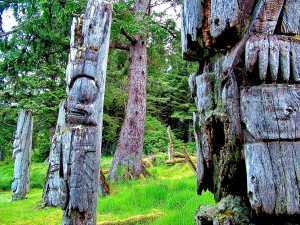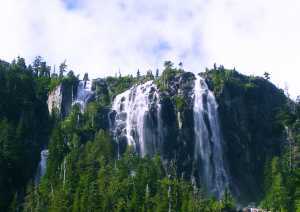Canada's natural beauty stretches from coast to coast. Brilliant blue glacier lakes, snow-dusted mountains, ancient forests, beautiful beaches — we really do have it all in this magnificently large country. Full of dramatically varying landscapes, Canada's scenery transforms as you traverse its vast terrain. From the west coast, B.C. morphs from a wine-producing desert in the Okanagan Valley to ski-worthy mountain ranges that spread from Whistler to Banff, Alberta. Then it's on to the flat, wide open prairies and before long, the colourful fishing towns of the east coast. And with all of Canada's natural wonders peppered in between, you've got one heck of a Canadian bucket list.
There are as many ways to explore Canada as there are wondrous natural attractions and riveting sights. Take a road trip through Ontario, explore the best local weekend destinations or head out on magnificent day trips from Toronto for hiking, canoeing and stargazing. There's no wrong way to experience this incredible country, and no bad place to start.
Sure, Niagara Falls is gorgeous — and many folks start their Canadian adventures here — but Canada has so many more natural wonders than that. We've done some digging and unearthed some of the best, lesser-known natural Canadian wonders that absolutely need to be on your travel hit list. From The Sleeping Giant in northern Ontario to dinosaur fossils in Alberta, these are some of the coolest natural attractions Canada has to offer — and they're just waiting to be discovered.
1. The Red Coast
P.E.I.
Yingna Cai via Shutterstock
No prizes for guessing what gave this area its name. There's red sand, red clay paths and red cliffs all contrasted against green fields and the blue of the Atlantic. As Canada's smallest province, P.E.I. is just crying out for a road trip, not to mention that it's been recently flushed with boutique hotels, cool cabins, wineries and breweries aplenty. Top tip: Stop at Canoe Cove at low tide, when the tidal pools are teaming with marine life.
2. Dinosaur Provincial Park
Brooks, Alberta
Ronnie Chua via Shutterstock
Walk with history's most famous giant reptiles at the aptly named Dinosaur Provincial Park in Alberta, where new fossils are being discovered all of the time. With 400 dinosaur skeletons, Alberta is home to some of the world's richest dino history. The undulating rocky terrain has a remarkably prehistoric feel to it. Head out on a hike and you might find some fossils of your own, or for guaranteed finds, you can take an organized fossil safari. Bring a tent and camp — you might even be lucky enough to spot the northern lights.
3. Panorama Ridge
Garibaldi Provincial Park, Whistler
Jason Wilde via Shutterstock
Hike to the top of this ridge in Garibaldi Provincial Park and you'll be rewarded with, well, a panorama — and a stunning one at that. Black Tusk, Garibaldi Lake, Mount Garibaldi, Castle Towers and more sprawl out before your eyes. And this is a hike that keeps on giving, because the beautiful landscapes surround you on your trek from start to finish.
4. Gwaii Haanas National Park
Haida Gwaii, B.C.

Bob Hilscher via Shutterstock
The Gwaii Haanas is a string of 138 islands about 80 kilometres off the coast of mainland B.C. Only reachable by boat or plane, this is about as remote as things get. The archipelago is the ancestral home of the Haida people, and in their language, "gwaii haanas" means "islands of beauty" and boy, does it deserve that title.
A visit here will have you gawking at ancient temperate rainforests of hemlock, spruce and cedar. Dive with loads of sea life, spot black bears and river otters, then broaden your horizons with a visit to some of the 500 identified Haida heritage sites.
The archipelago is co-managed by the government of Canada and the Council of the Haida Nation — a pioneering partnership with a mutual commitment to protecting Gwaii Haanas itself. Plan your trip carefully, as all visits require a permit, whether they're for a day or a week.
5. The Sleeping Giant
Thunder Bay, Ontario
Northern Exposure by JR via Shutterstock
From Thunder Bay, this massive rock formation on the Sibley Peninsula looms large against the skyline, resembling a giant sleeping on its back. The rocky mass is actually the remains of an ancient volcano, and today the area is a national park. View it from a distance to see the giant or visit the park to hike to the top of the Giant Trail and Thunder Bay Lookout. This landmark is so well-loved that Canadians actually voted it their favourite natural wonder, ahead of Niagara Falls. The outcrop is wreathed in legend, too: It's said that the giant sleeps above a silver mine that belonged to the Ojibway, who were promised silver in return for never waking the giant.
6. Bay of Fundy
New Brunswick and Nova Scotia
Peter Lloyd
Stretching between New Brunswick and Nova Scotia, the Bay of Fundy has tides with enough power to temporarily reverse the flow of several rivers that end in the bay. And at its highest, the tide rises a whopping 16 metres — the highest in the world. That's all pretty wondrous in its own right, but it's pretty to look at, too. The eroded "flower pot" formations feature trees growing out of surreal-looking rocky outcrops that stand on shore at low tide or in the water at high tide.
7. Della Falls
Strathcona Provincial Park, British Columbia

Clayoquot
Niagara Falls is boring... said no one ever. But where Niagara has a terrifyingly powerful flow, the lesser-known Della Falls in British Columbia has height — at 440 metres tall, it's three times higher than our best-known natural landmark. Della Falls is best reached by boat, followed by a 22.5-kilometre uphill trek. But if that sounds too tiring, the falls still look great from further away.
8. Spotted Lake
Osoyoos, Okanagan Valley, B.C.
Rowdy Soetisna via Shutterstock
There are several things to love about the Spotted Lake in Osoyoos, B.C. First up, it's a lake that sits in the middle of Canada's only true desert, which is pretty amazing in itself. With the heat of summer, the lake evaporates, leaving mineral deposits behind in circles that look just like a leopard's spots. With such beauty, it's no surprise that this site is sacred for the Syilx or Okanagan people. It sits on private Okanagan property, and if you visit, it's important to respect its ecological and cultural significance.
9. Cheltenham Badlands
Caledon, Ontario
Olga Gabay via Shutterstock
Badlands are tracts of heavily eroded, uncultivable land with little vegetation. It may not sound like it, but they're also pretty beautiful. Mars-like red rock landscapes stretch as far as the eye can see, windswept and barren. A hike in the Cheltenham Badlands in Caledon makes for an experience that's out of this world. As picturesque as the landscape is, the story of the badlands is a lesson to be learned: The area got its otherworldly terrain from poor farming practices in the early 20th century that left the land unusable.
10. The Smoking Hills
Cape Bathurst, Northwest Territories
View on Instagram
Reminiscent of the billowing slopes of Mordor, these hills in Cape Bathurst, Northwest Territories constantly give off thick plumes of smoke. But don't worry — this smouldering coastline is a natural phenomenon. The hills are packed with sulphur-rich lignite that ignites when it's exposed to air. The area has been burning and puffing away for centuries.
